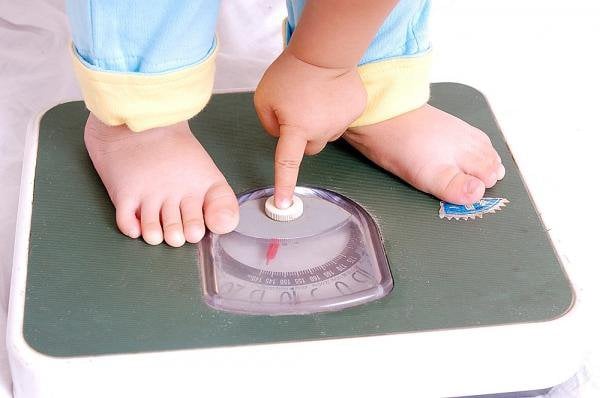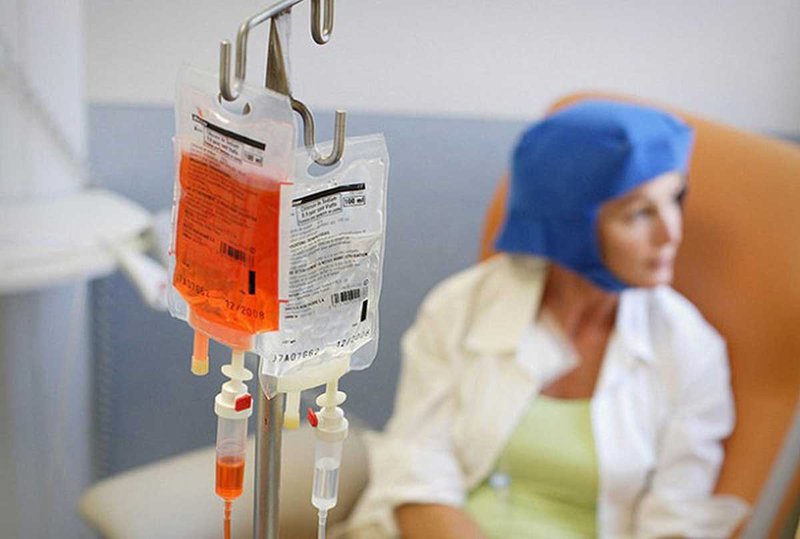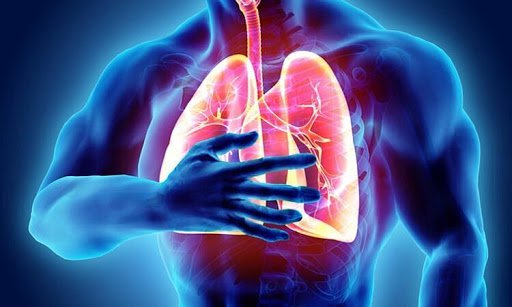Calculation of glomerular filtration rate according to blood creatinine
This is an automatically translated article.
The article was professionally consulted by Master, Doctor Nguyen Thi Thanh Thuy - Endocrinologist - Dialysis - Kidney Transplant - Department of Medical Examination & Internal Medicine - Vinmec Central Park International General Hospital.
The glomerular filtration rate is a value to help assess and identify existing kidney damage. The higher the glomerular filtration rate, the better the kidneys work. There are many ways to calculate the glomerular filtration rate, such as calculating blood creatinine, based on the MDRD formula,...
1. Glomerular filtration rate
The glomeruli are small, inertial filters in the kidneys that allow waste products to be eliminated from the blood, while preventing the loss of important components such as proteins and blood cells. Each day, two healthy kidneys filter about 200 liters of blood and produce about 2 liters of urine.
Glomerular filtration rate (GFR) is the amount of blood that is filtered by the kidneys in a unit of time, usually in minutes. The glomerular filtration rate is a measure of how well the kidneys filter wastes out of the blood and is the best indicator of kidney function. The higher the glomerular filtration rate, the better the kidney's ability to work and eliminate waste in the blood. Over time, with age, the glomerular filtration rate also decreases and the glomerular filtration rate depends on gender.
Normal glomerular filtration rate in healthy adults is >90mL/min/1.73m2. Glomerular filtration rate declines with age even in people without chronic kidney disease. Normal glomerular filtration rate based on age is as follows:
From 20-29 years old, about 116 mL/min/1.73 m2. From 30-39 years old, about 107 mL/min/1.73 m2. From 40-49 years old over 99 mL/min/1.73 m2 From 50-59 years old over 93 mL/min/1.73 m2 From 60-69 years old over 85 mL/min/1.73 m2. From over 70 years old over 75 mL/min/1.73 m2.
Glomerular filtration rate (GFR) is the amount of blood that is filtered by the kidneys in a unit of time, usually in minutes. The glomerular filtration rate is a measure of how well the kidneys filter wastes out of the blood and is the best indicator of kidney function. The higher the glomerular filtration rate, the better the kidney's ability to work and eliminate waste in the blood. Over time, with age, the glomerular filtration rate also decreases and the glomerular filtration rate depends on gender.
Normal glomerular filtration rate in healthy adults is >90mL/min/1.73m2. Glomerular filtration rate declines with age even in people without chronic kidney disease. Normal glomerular filtration rate based on age is as follows:
From 20-29 years old, about 116 mL/min/1.73 m2. From 30-39 years old, about 107 mL/min/1.73 m2. From 40-49 years old over 99 mL/min/1.73 m2 From 50-59 years old over 93 mL/min/1.73 m2 From 60-69 years old over 85 mL/min/1.73 m2. From over 70 years old over 75 mL/min/1.73 m2.
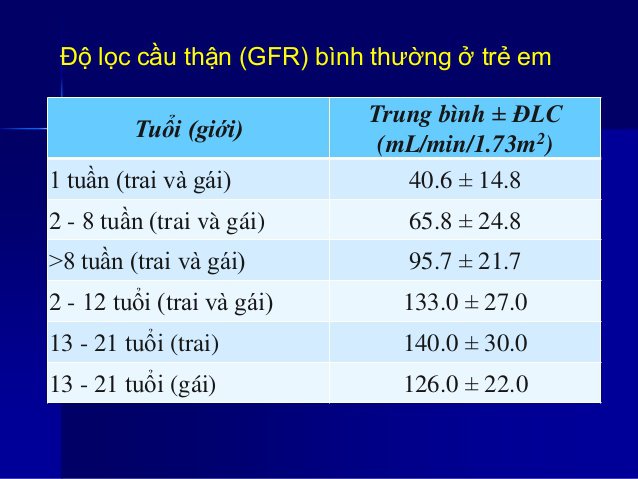
Độ lọc cầu thận ở trẻ em
2. Calculation of glomerular filtration rate according to blood creatinine
2.1 Blood Creatinine
It is very difficult to calculate the normal glomerular filtration rate, and there is no means of measuring the glomerular filtration rate. Therefore, a formula for calculating glomerular filtration rate is based on creatinine in blood and urine.
Creatinine is a waste product produced during muscle contraction, people rely on the creatinine index to calculate the glomerular filtration rate due to:
Creatinine has a small molecular weight, so it is easily filtered through the glomerulus, not blocked by the renal tubules. reabsorbed, the distal tubule secretes a negligible amount. Creatinine clearance is approximately equivalent to glomerular filtration rate. It is easily quantified by biochemical tests.
Creatinine is a waste product produced during muscle contraction, people rely on the creatinine index to calculate the glomerular filtration rate due to:
Creatinine has a small molecular weight, so it is easily filtered through the glomerulus, not blocked by the renal tubules. reabsorbed, the distal tubule secretes a negligible amount. Creatinine clearance is approximately equivalent to glomerular filtration rate. It is easily quantified by biochemical tests.
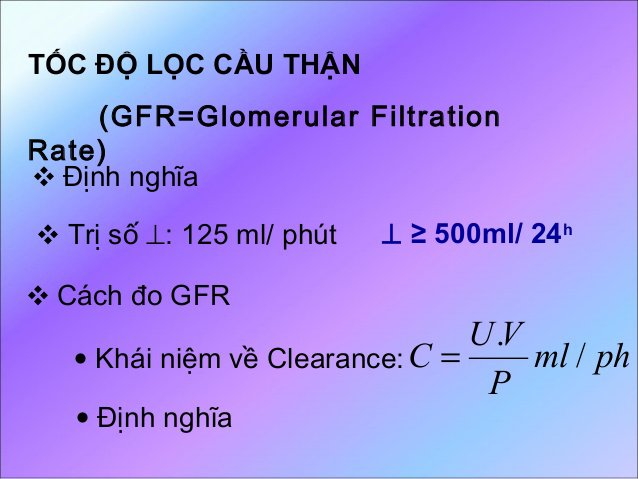
Công thức tính độ lọc cầu thận
2.2 Formula for calculating glomerular filtration rate according to blood creatinine
There are 3 formulas to calculate the glomerular filtration rate according to blood creatinine as follows:
Formula 1: Based on age, sex and blood creatinine concentration to calculate the estimated glomerular filtration rate:
GFR (mL/min/1.73) m2) = 175 × (Scr)-1,154 × (age)-0.203 × (0.742 if female) × (1,212 if African)
Where:
eGFR(estimated Glomerular Filtration Rate): is the glomerular filtration rate estimated renal Scr: blood creatinine concentration Formula 2: Estimated glomerular filtration rate equivalent to creatinine clearance based on the creatinine in blood and urine. Conduct 24-hour urine collection, to measure urine volume and creatinine excretion in 24 hours, and measure blood creatinine:
GFR = CrCl (mL/min) = (urine UCr.V)/(SCr.T) ).
Where:
CrCl: creatinine clearance UCr: urine creatinine concentration (mg/dL) V urine: urine collection volume (mL) SCr: blood creatinine concentration collected at the midpoint urine collection interval (mg/dL) T: Urine collection time (in minutes) Formula 3: For adults and not too obese
For routine measurement of clearance The patient's creatinine also encountered many difficulties, there are many steps, so there is a possibility of errors such as: collecting urine is not enough, the concentration of creatinine in the serum is not collected at the right time. Therefore, researchers have developed methods to estimate creatinine clearance from serum creatinine values and other characteristics of patients of different ages, sexes and regions of life.
The most commonly used formula for adults aged 18 years and over:
For men: CrClMeasurement = [(140 – age).weight]/(72.SCr) For women: CrCloc amount = [(140 – age).weight]/(72.SCr).0.85 Where:
Estimated CrCl: estimated creatinine clearance (mL/min) Age: In years Weight: Calculate in kg SCr: serum creatinine concentration (mg/dL) In summary, glomerular filtration rate can assess renal filtration function, and stage of chronic kidney disease. From there, appropriate care and treatment measures can be given. For cases with high risk of kidney disease such as hypertension, diabetes, or signs of suspected kidney disease, it is necessary to check the glomerular filtration rate to be able to diagnose and take measures. early intervention.
Formula 1: Based on age, sex and blood creatinine concentration to calculate the estimated glomerular filtration rate:
GFR (mL/min/1.73) m2) = 175 × (Scr)-1,154 × (age)-0.203 × (0.742 if female) × (1,212 if African)
Where:
eGFR(estimated Glomerular Filtration Rate): is the glomerular filtration rate estimated renal Scr: blood creatinine concentration Formula 2: Estimated glomerular filtration rate equivalent to creatinine clearance based on the creatinine in blood and urine. Conduct 24-hour urine collection, to measure urine volume and creatinine excretion in 24 hours, and measure blood creatinine:
GFR = CrCl (mL/min) = (urine UCr.V)/(SCr.T) ).
Where:
CrCl: creatinine clearance UCr: urine creatinine concentration (mg/dL) V urine: urine collection volume (mL) SCr: blood creatinine concentration collected at the midpoint urine collection interval (mg/dL) T: Urine collection time (in minutes) Formula 3: For adults and not too obese
For routine measurement of clearance The patient's creatinine also encountered many difficulties, there are many steps, so there is a possibility of errors such as: collecting urine is not enough, the concentration of creatinine in the serum is not collected at the right time. Therefore, researchers have developed methods to estimate creatinine clearance from serum creatinine values and other characteristics of patients of different ages, sexes and regions of life.
The most commonly used formula for adults aged 18 years and over:
For men: CrClMeasurement = [(140 – age).weight]/(72.SCr) For women: CrCloc amount = [(140 – age).weight]/(72.SCr).0.85 Where:
Estimated CrCl: estimated creatinine clearance (mL/min) Age: In years Weight: Calculate in kg SCr: serum creatinine concentration (mg/dL) In summary, glomerular filtration rate can assess renal filtration function, and stage of chronic kidney disease. From there, appropriate care and treatment measures can be given. For cases with high risk of kidney disease such as hypertension, diabetes, or signs of suspected kidney disease, it is necessary to check the glomerular filtration rate to be able to diagnose and take measures. early intervention.
Please dial HOTLINE for more information or register for an appointment HERE. Download MyVinmec app to make appointments faster and to manage your bookings easily.
This article is written for readers from Sài Gòn, Hà Nội, Hồ Chí Minh, Phú Quốc, Nha Trang, Hạ Long, Hải Phòng, Đà Nẵng.


